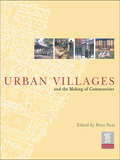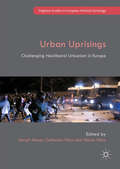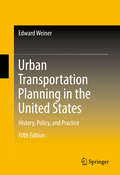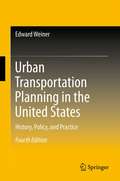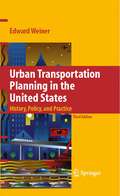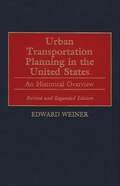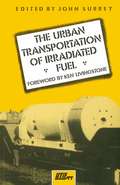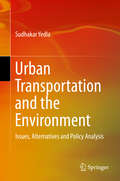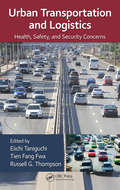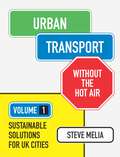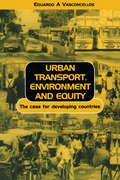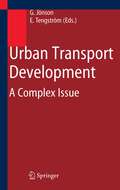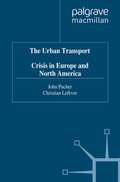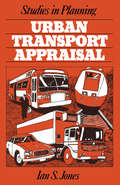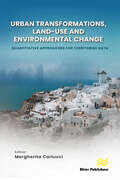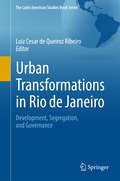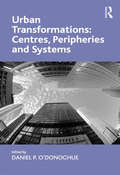- Table View
- List View
Urban Violence, Resilience and Security: Governance Responses in the Global South
Written in a comprehensive yet accessible style, Urban Violence, Resilience and Security investigates the diverse nature of urban violence within Latin America, Asia and Africa. It further analyzes how regular and irregular governing mechanisms can provide human security, despite the presence of chronic violence. The empirically rich and conceptually grounded contributions of established and emerging scholars evaluate the current state and future trajectory of urban development. They also question common explanations of the drivers of violence in urban areas and also provide measured recommendations for improved policy and future governance. Chapters thoroughly examine the opportunities and hazards of focusing on resilience as the only method to improve security and identify governance and policy practices that can move beyond the rhetoric of resilience to evaluate diverse approaches to attaining human security in urban areas of the Global South.This invigorating book will be an excellent resource for academic researchers interested in urban dynamics in the Global South as well as scholars embarking on geography, human security, political science and policy studies. Based on a set of original case studies, policymakers will also benefit from the questions and challenges to the conventional approaches to urban planning and governance that it raises.
Urban Violence in the Middle East: Changing Cityscapes in the Transition from Empire to Nation State (Space and Place #14)
by Ulrike Freitag Nelida Fuccaro Claudia Ghrawi Nora LafiCovering a period from the late eighteenth century to today, this volume explores the phenomenon of urban violence in order to unveil general developments and historical specificities in a variety of Middle Eastern contexts. By situating incidents in particular processes and conflicts, the case studies seek to counter notions of a violent Middle East in order to foster a new understanding of violence beyond that of a meaningless and destructive social and political act. Contributions explore processes sparked by the transition from empires — Ottoman and Qajar, but also European — to the formation of nation states, and the resulting changes in cityscapes throughout the region.
Urban Villages and the Making of Communities
by Peter Neal HRH The Prince of WalesUrban regeneration is currently at the forefront of the political and professional agenda worldwide. There is a growing desire to identify and deliver solutions that not only define models of sustainable and identifiable urban form, but also underpin a real sense of a vibrant community. The design philosophy of Urban Villages has gained significant weight with government policy-makers, planners, designers and developers and is becoming a popular model in achieving a successful and flexible urban renaissance. This book documents both the roots of the Urban Village movement and its application in contemporary society. A series of essays by eminent practitioners offers particular urban perspectives. A detailed compendium of successful case-studies provides clear technical information
Urban Villages And The Making Of Communities
by Peter NealUrban regeneration is currently at the forefront of the political and professional agenda worldwide. There is a growing desire to identify and deliver solutions that not only define models of sustainable and identifiable urban form, but also underpin a real sense of a vibrant community. The design philosophy of Urban Villages has gained significant weight with government policy-makers, planners, designers and developers and is becoming a popular model in achieving a successful and flexible urban renaissance. This book documents both the roots of the Urban Village movement and its application in contemporary society. A series of essays by eminent practitioners offers particular urban perspectives. A detailed compendium of successful case-studies provides clear technical information.
Urban Villages: The Making of Community
by NealUrban regeneration is currently at the forefront of the political and professional agenda worldwide. There is a growing desire to identify and deliver solutions that not only define models of sustainable and identifiable urban form, but also underpin a real sense of a vibrant community. The design philosophy of Urban Villages has gained significant weight with government policy-makers, planners, designers and developers and is becoming a popular model in achieving a successful and flexible urban renaissance. This book documents both the roots of the Urban Village movement and its application in contemporary society. A series of essays by eminent practitioners offers particular urban perspectives. A detailed compendium of successful case-studies provides clear technical information. Urban Villages and the Making of Communities offers a professional resource, a teaching tool and learning aid.
Urban Villages: The Making of Communities (PDF)
by NealUrban regeneration is currently at the forefront of the political and professional agenda worldwide. There is a growing desire to identify and deliver solutions that not only define models of sustainable and identifiable urban form, but also underpin a real sense of a vibrant community. The design philosophy of Urban Villages has gained significant weight with government policy-makers, planners, designers and developers and is becoming a popular model in achieving a successful and flexible urban renaissance. This book documents both the roots of the Urban Village movement and its application in contemporary society. A series of essays by eminent practitioners offers particular urban perspectives. A detailed compendium of successful case-studies provides clear technical information. Urban Villages and the Making of Communities offers a professional resource, a teaching tool and learning aid.
Urban Uprisings: Challenging Neoliberal Urbanism in Europe (Palgrave Studies in European Political Sociology)
by Margit Mayer Catharina Thörn Håkan ThörnThis book analyses the waves of protests, from spontaneous uprisings to well-organized forms of collective action, which have shaken European cities over the last decade. It shows how analysing these protests in connection with the structural context of neoliberal urbanism and its crises is more productive than standard explanations. Processes of neoliberalisation have caused deeply segregated urban landscapes defined by deepening social inequality, rising unemployment, racism, securitization of urban spaces and welfare state withdrawal, particularly from poor peripheral areas, where tensions between marginalized youth and police often manifest in public spaces. Challenging a conventional distinction made in research on protest, the book integrates a structural analysis of processes of large scale urban transformation with analyses of the relationship between 'riots' and social movement action in nine countries: France, Greece, England, Germany, Spain, Poland, Denmark, Sweden and Turkey.
Urban Transportation Planning in the United States: History, Policy, and Practice
by Edward WeinerIn this new fifth edition, there is a strong focus on the increasing concern over infrastructure resilience from the threat of serious storms, human activity, and population growth. The new edition also looks technologies that urban transportation planners are increasingly focused on, such as vehicle to vehicle communications and driver-less cars, which have the potential to radically improve transportation. This book also investigates the effects of transportation on the health of travelers and the general public, and the ways in which these concerns have become additional factors in the transportation and infrastructure planning and policy process. The development of U.S. urban transportation policy over the past half-century illustrates the changing relationships among federal, state, and local governments. This comprehensive text examines the evolution of urban transportation planning from early developments in highway planning in the 1930s to today’s concerns over sustainable development, security, and pollution control. Highlighting major national events, the book examines the influence of legislation, regulations, conferences, federal programs, and advances in planning procedures and technology. The volume provides in-depth coverage of the most significant event in transportation planning, the Federal-Aid Highway Act of 1962, which created a federal mandate for a comprehensive urban transportation planning process, carried out cooperatively by states and local governments with federal funding. Claiming that urban transportation planning is more sophisticated, costly, and complex than its highway and transit planning predecessors, the book demonstrates how urban transportation planning evolved in response to changes in such factors as the environment, energy, development patterns, intergovernmental coordination, and federal transit programs. This new edition includes analyses of the growing threats to infrastructure, new projects in infrastructure resilience, the promise of new technologies to improve urban transportation, and the recent shifts in U.S. transportation policy. This book will be of interest to researchers and practitioners in transportation legislation and policy, eco-justice, and regional and urban planning.
Urban Transportation Planning in the United States: History, Policy, and Practice
by Edward WeinerThe development of U.S. urban transportation policy over the past half-century illustrates the changing relationships among federal, state, and local governments. This comprehensive text examines the evolution of urban transportation planning from early developments in highway planning in the 1930s to today’s concerns over sustainable development, security, and pollution control. Highlighting major national events, the book examines the influence of legislation, regulations, conferences, federal programs, and advances in planning procedures and technology. The volume provides in-depth coverage of the most significant event in transportation planning, the Federal-Aid Highway Act of 1962, which created a federal mandate for a comprehensive urban transportation planning process, carried out cooperatively by states and local governments with federal funding. Claiming that urban transportation planning is more sophisticated, costly, and complex than its highway and transit planning predecessors, the book demonstrates how urban transportation planning evolved in response to changes in such factors as the environment, energy, development patterns, intergovernmental coordination, and federal transit programs. This updated, revised, and expanded edition features two new chapters on global climate change and managing under conditions of constrained resources, and covers the impact of the most recent legislation, 50 years after the Highway Act of 1962, emphasizing such timely issues as security, oil dependence, performance measurement, and public-private sector collaboration.
Urban Transportation Planning in the United States: History, Policy, and Practice
by Edward WeinerThis comprehensive text examines the evolution of urban transportation planning in the United States, from early developments in highway planning in the 1930s to today’s concerns over sustainable development, security, and pollution control.
Urban Transportation Planning in the United States: An Historical Overview
by Edward WeinerThe development of U.S. urban transportation policy over the past 50 years illustrates the changing relationship between federal, state, and local governments. This comprehensive text examines the evolution of urban transportation planning from early developments in highway planning in the 1930s to the concern for sustainable development and pollution emissions. Focusing on major national events, the book discusses the influence of legislation, regulations, conferences, federal programs, and advances in planning procedures and technology.The book offers an in-depth look at the most significant event in transportation planning—the Federal-Aid Highway Act of 1962. Creating a federal mandate for a comprehensive urban transportation planning process carried out cooperatively by states and local governments with federal funding, this act was crucial in the spread of urban transporation. Claiming that urban transportation planning is more sophisticated, costly, and complex than its highway and transit planning predecessors, the book demonstrates how urban transportation planning evolved in response to changes in such factors as environment, energy, development patterns, intergovernmental coordination, and federal transit programs. It further illustrates how broader concerns for global climate change and sustainable development have braided the purview of transportation planning.
Urban Transportation and the Environment: Issues, Alternatives and Policy Analysis
by Sudhakar YedlaThe book deals with urban transportation planning in light of environmental sustainability and social equity. It begins with a review of the Indian urban transportation system and the issues surrounding it, and discusses the alternatives and policy directions that are being considered. It examines all the environmental issues arising out of transportation as a sector and assesses the alternatives that can be considered to improve sustainability. Further, the book not only analyses transportation modes that cater to the travel needs of the poor, so as to make them more socially equitable, but also explores measures to promote them using a multi-criteria and multi-stakeholder approach. It addresses the barriers that are bottlenecks for the implementation of cleaner fuels and modes of transport and presents an incremental approach to tackle environmental concerns, including climate change, when planning transportation in the long term. Finally, it presents the dilemma of city administrators in choosing between strategies aimed at local pollution control and those aimed at limiting global emissions. This unique book provides a comprehensive overview of “sustainable transportation.” It discusses all the important elements that are essential to transportation planners and policy makers when planning a city’s transportation. Theoretical presentations augmented by case-specific research work and the methodology used in some of the modules, make it a valuable resource for researchers working at the forefront of this area.
Urban Transportation and Logistics: Health, Safety, and Security Concerns
by Eiichi Taniguchi Tien Fang Fwa Russell G. ThompsonAlthough society has become increasingly dependent on the timely operation of logistics systems, we still face many problems regarding efficiency, the environment, energy consumption, and safety in urban transport and logistics under normal cases and in disasters. As such, understanding how to address these challenges has become essential for creat
Urban Transport without the hot air: Volume 1: Sustainable solutions for UK cities (without the hot air #4)
by Steve MeliaThe UK population will reach 70 million by 2027. How will all these people get around? Is building more, wider roads really the solution? If you've ever studied, worked in or used transport, there's a good chance you'll have stopped one day and asked yourself 'why?'. With population numbers rising and more than three-quarters of the British population living in urban areas, cities are becoming congested – and the air increasingly stinky!In Volume 1 of Urban Transport without the hot air, transport and planning specialist Steve Melia dispels long-standing myths surrounding transportation issues in the United Kingdom. From car ownership, public transport and cycling to airports and the belief that we're building too many flats, he discusses the challenges and values of urban planning.This is also a practical book filled with sustainable solutions to improve the future of our transport system. By drawing on the experience of London, Bristol, Cambridge and other European towns, Steve argues that we can create cleaner and more pleasant places to live, and a more sustainable economy. It also includes evidence from both Steve's research, and studies carried out by respected academics and experts, providing reliable and informative insights on urban living.Persuasive and accessibly written, and is a must-read for anyone interested or involved in transport and urban planning.
Urban Transport Environment and Equity: The Case for Developing Countries
by Eduardo Alcantara VasconcellosTraditional transport planning has generated transport systems that propagate an unfair distribution of accessibility and have environmental and safety issues. This book highlights the importance of social and political aspects of transport policy and provides a methodology to support this approach. It emphasizes the importance of co-ordinating urban, transport and traffic planning, and addresses the major challenge of modifying the building and use of roads. The author makes suggestions for innovative and radical new measures towards an equitable and sustainable urban environment.
Urban Transport Environment and Equity: The Case for Developing Countries
by Eduardo Alcantara VasconcellosTraditional transport planning has generated transport systems that propagate an unfair distribution of accessibility and have environmental and safety issues. This book highlights the importance of social and political aspects of transport policy and provides a methodology to support this approach. It emphasizes the importance of co-ordinating urban, transport and traffic planning, and addresses the major challenge of modifying the building and use of roads. The author makes suggestions for innovative and radical new measures towards an equitable and sustainable urban environment.
Urban Transport Development: A Complex Issue
by Gunella Jönson Emin TengströmUrban Transport Development is a contribution to the ongoing global discussion on the future of urban transport. The main themes are how to cope with the complexity of urban transport development and the process of change including its determining factors. The role of leadership in the development process is the key issue. Main areas of discussion are the historical background, the diversity and complexity of present problems, and the outcome of attempts to promote positive future development in urban environments around the world.
The Urban Transport Crisis in Europe and North America
by J. Pucher C. LefevreIncreasing levels of auto ownership and use are causing severe social, economic, and environmental problems in virtually all countries in Europe and North America. This book documents the worsening transport crisis and differences among countries in their urban transport and land-use systems. The focus is on public policies to deal with urban transport problems. Through in-depth case studies of eight countries, the book seeks to evaluate the effectiveness of alternative solutions to transport problems, and thus a way out of the transport crisis.
Urban Transformations, Land-use, and Environmental Change: Quantitative Approaches for Territorial Data
by Margherita CarlucciThis book provides interesting insights for the identification of socioeconomic, demographic and territorial factors that affect structural disparities in local economies. Urban development is the result of demographic dynamics at the local level, connected to socioeconomic factors, and of economic growth, whose fluctuations are particularly sensitive to the economic cycle in countries, such as the ones in the Mediterranean basin, characterized by greater informality of the sector and limited public/social housing. Our objective is to provide a contribution to sustainability planning, explaining the linkage between forms of urban development and economic growth, providing policy indications for integrated spatial planning, and for cohesion policies that may leverage social and economic competitiveness.
Urban Transformations, Land-use, and Environmental Change: Quantitative Approaches for Territorial Data
by Margherita CarlucciThis book provides interesting insights for the identification of socioeconomic, demographic and territorial factors that affect structural disparities in local economies. Urban development is the result of demographic dynamics at the local level, connected to socioeconomic factors, and of economic growth, whose fluctuations are particularly sensitive to the economic cycle in countries, such as the ones in the Mediterranean basin, characterized by greater informality of the sector and limited public/social housing. Our objective is to provide a contribution to sustainability planning, explaining the linkage between forms of urban development and economic growth, providing policy indications for integrated spatial planning, and for cohesion policies that may leverage social and economic competitiveness.
Urban Transformations in Rio de Janeiro: Development, Segregation, and Governance (The Latin American Studies Book Series)
by Luiz Cesar de Queiroz RibeiroThis book provides an overview of urban transformations taking place in the city of Rio de Janeiro, Brazil in the last three decades. It analyses urban dynamics within the metropolis and its relationship with Brazilian urban networks. This book is written by researchers from the Brazilian Metropolitan Observatory in Rio de Janeiro. The aim is to study urban transformation and stagnation with regards to urban mobility and infrastructure, social analysis of territory, housing and housing market, metropolitan governance, demography, residential segregation and inequality of opportunities, among other topics.
Urban Transformations: Centres, Peripheries and Systems
by Daniel P. O'DonoghueDefinitions of urban entities and urban typologies are changing constantly to reflect the growing physical extent of cities and their hinterlands. These include suburbs, sprawl, edge cities, gated communities, conurbations and networks of places and such transformations cause conflict between central and peripheral areas at a range of spatial scales. This book explores the role of cities, their influence and the transformations they have undertaken in the recent past. Ways in which cities regenerate, how plans change, how they are governed and how they react to the economic realities of the day are all explored. Concepts such as polycentricity are explored to highlight the fact that cities are part of wider regions and the study of urban geography in the future needs to be cognisant of changing relationships within and between cities. Bringing together studies from around the world at different scales, from small town to megacity, this volume captures a snapshot of some of the changes in city centres, suburbs, and the wider urban region. In doing so, it provides a deeper understanding of the evolving form and function of cities and their associated peripheral regions as well as their impact on modern twenty-first century landscapes.
Urban Transformations: Centres, Peripheries and Systems
by Daniel P. O'DonoghueDefinitions of urban entities and urban typologies are changing constantly to reflect the growing physical extent of cities and their hinterlands. These include suburbs, sprawl, edge cities, gated communities, conurbations and networks of places and such transformations cause conflict between central and peripheral areas at a range of spatial scales. This book explores the role of cities, their influence and the transformations they have undertaken in the recent past. Ways in which cities regenerate, how plans change, how they are governed and how they react to the economic realities of the day are all explored. Concepts such as polycentricity are explored to highlight the fact that cities are part of wider regions and the study of urban geography in the future needs to be cognisant of changing relationships within and between cities. Bringing together studies from around the world at different scales, from small town to megacity, this volume captures a snapshot of some of the changes in city centres, suburbs, and the wider urban region. In doing so, it provides a deeper understanding of the evolving form and function of cities and their associated peripheral regions as well as their impact on modern twenty-first century landscapes.


